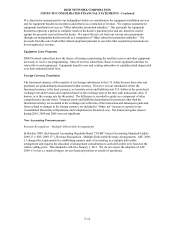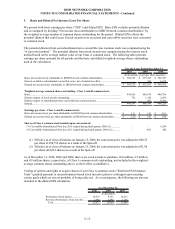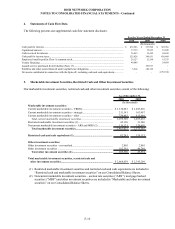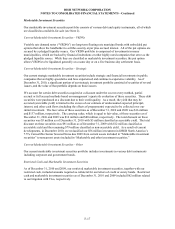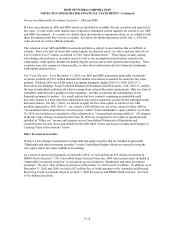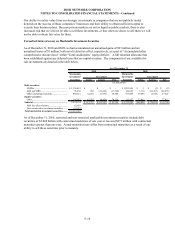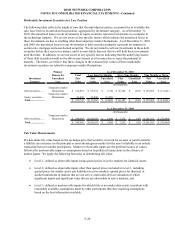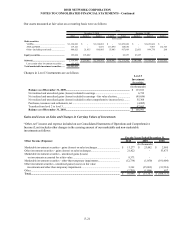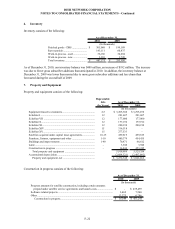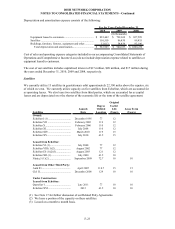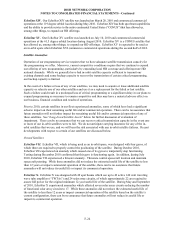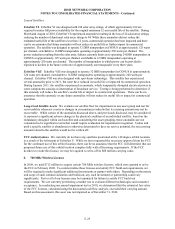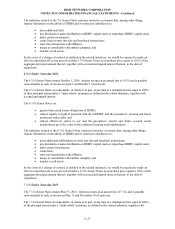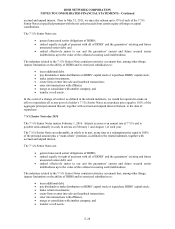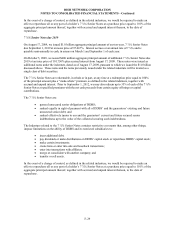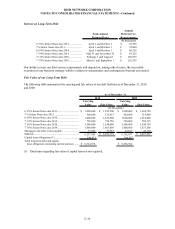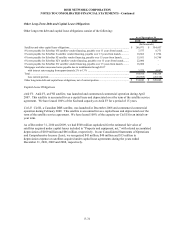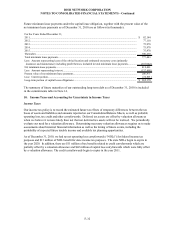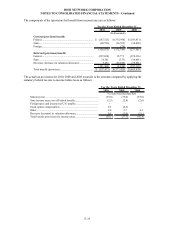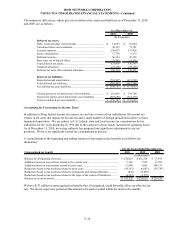Dish Network 2010 Annual Report Download - page 109
Download and view the complete annual report
Please find page 109 of the 2010 Dish Network annual report below. You can navigate through the pages in the report by either clicking on the pages listed below, or by using the keyword search tool below to find specific information within the annual report.
DISH NETWORK CORPORATION
NOTES TO CONSOLIDATED FINANCIAL STATEMENTS - Continued
F-24
EchoStar XIV. Our EchoStar XIV satellite was launched on March 20, 2010 and commenced commercial
operations at the 119 degree orbital location during May 2010. EchoStar XIV has both spot beam capabilities
and the ability to provide service to the entire continental United States (“CONUS”) that has allowed us,
among other things, to expand our HD offerings.
EchoStar XV. Our EchoStar XV satellite was launched on July 10, 2010 and commenced commercial
operations at the 61.5 degree orbital location during August 2010. EchoStar XV is a CONUS satellite that
has allowed us, among other things, to expand our HD offerings. EchoStar XV is expected to be used as
an in-orbit spare when EchoStar XVI commences commercial operations during the second half of 2012.
Satellite Anomalies
Operation of our programming service requires that we have adequate satellite transmission capacity for
the programming we offer. Moreover, current competitive conditions require that we continue to expand
our offering of new programming, particularly by expanding local HD coverage and offering more HD
national channels. While we generally have had in-orbit satellite capacity sufficient to transmit our
existing channels and some backup capacity to recover the transmission of certain critical programming,
our backup capacity is limited.
In the event of a failure or loss of any of our satellites, we may need to acquire or lease additional satellite
capacity or relocate one of our other satellites and use it as a replacement for the failed or lost satellite.
Such a failure could result in a prolonged loss of critical programming or a significant delay in our plans to
expand programming as necessary to remain competitive and thus may have a material adverse effect on
our business, financial condition and results of operations.
Prior to 2010, certain satellites in our fleet experienced anomalies, some of which have had a significant
adverse impact on their remaining useful life and/or commercial operation. There can be no assurance that
future anomalies will not further impact the remaining useful life and/or commercial operation of any of
these satellites. See “Long-Lived Satellite Assets” below for further discussion of evaluation of
impairment. There can be no assurance that we can recover critical transmission capacity in the event one
or more of our in-orbit satellites were to fail. We do not anticipate carrying insurance for any of the in-
orbit satellites that we use, and we will bear the risk associated with any in-orbit satellite failures. Recent
developments with respect to certain of our satellites are discussed below.
Owned Satellites
EchoStar VII. EchoStar VII, which is being used as an in-orbit spare, was designed with four gyros, of
which three are required to properly control the positioning of the satellite. During October 2010,
EchoStar VII experienced an anomaly which caused one of its gyros to temporarily stop functioning.
Testing during December 2010 confirmed that this gyro is functioning again. In addition, during July
2010, EchoStar VII experienced a thruster anomaly. Thrusters control spacecraft location and maintain
spacecraft pointing. While these anomalies did not reduce the estimated useful life of the satellite to less
than 12 years or impact commercial operation of the satellite, there can be no assurance that future
anomalies will not reduce its useful life or impact its commercial operation.
EchoStar X. EchoStar X was designed with 49 spot beams which use up to 42 active 140 watt traveling
wave tube amplifiers (“TWTAs”) and 24 solar array circuits, of which approximately 22 are required to
assure full power for the original minimum 12-year useful life of the satellite. During May and September
of 2010, EchoStar X experienced anomalies which affected seven solar array circuits reducing the number
of functional solar array circuits to 17. While these anomalies did not reduce the estimated useful life of
the satellite to less than 12 years or impact commercial operation of the satellite based on the satellite’s
current configuration, there can be no assurance that future anomalies will not reduce its useful life or
impact its commercial operation.


